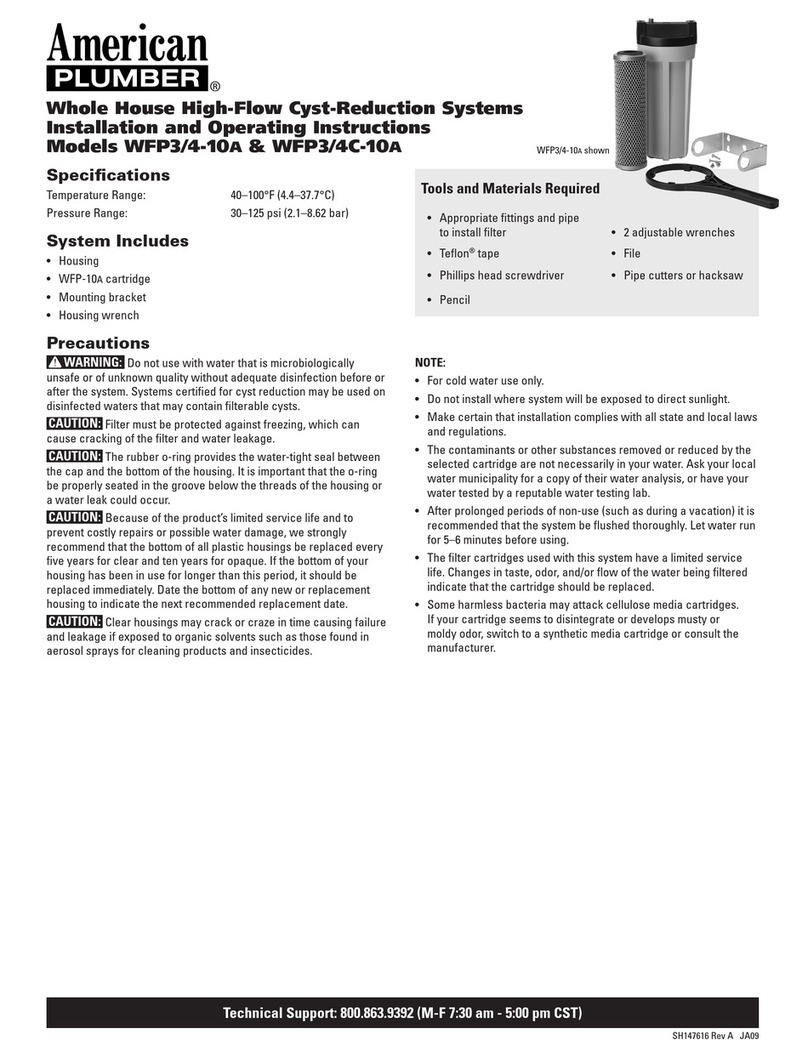
Leaks between bottom of housing and cap
1. Ensure sump is tightly screwed to cap. If it still leaks close the cold
water supply and tank valves.
2. Clean black rubber O-ring and lubricate with clean silicone grease.
With two fingers, insert O-ring in groove below threads of housing
and press into place. Tighten housing back onto cap.
3. Open the cold water supply and tank valve.
If leaks persist, call Technical Support.
Leaks on tank valve assembly
1. Open drinking water faucet to drain storage tank. Let drinking water
faucet run until it drips. Turn off cold water supply.
2. Push in on white collar of tank valve fitting and pull out tubing.
Unscrew the tank valve from the storage tank. Rewrap threads on
top of the tank with Teflon®tape. Screw tank valve back onto tank.
Trim 1/2-inch from end of tubing and reinsert 5/8-inch into tank
valve fitting.
3. Open the cold water supply and shut off the reverse osmosis
faucet. Let the system pressurize for several hours and check for
leaks. Check again after tank is fully pressurized.
Leaks on quick-connect fittings
1. Close the cold water supply and tank valve.
2. Depress plastic collar and pull out tubing.
3. Cut off 1 inch of tubing and place a mark 5/8-inch from end of
tubing. Tubing should be cut squarely. The internal and external
burrs should be removed.
4. Push tubing 5/8-inch into fitting.
5. Open the cold water supply and tank valve. If leaks persist, call
Technical Support.
No flow or slow flow from the brine (drain) line
Less than 1½ cups per minute
NOTE: Before checking brine (or reject) flow, make sure the system
is producing water by turning off the valve on the storage tank
and opening the faucet. Water should drip from faucet.
1. Examine the P5 and EPM10 pre-filters. If clogged, replace (see
Replacing the Pre-Filter and Post-Filter on page 8) and recheck the
brine (or reject) flow rate.
2. If the pre-filters are not at fault, the brine (or drain) flow controller is
probably clogged. Call Technical Support.
High TDS in Product Water
1. If high TDS (Total Dissolved Solids) is detected in the product water,
the RO Cartridge may need to be replaced or the reject flow control
tubing may be clogged. If this is a new installation, call Technical
Support.
2. Otherwise, draw 1 gallon of water from the unit. After 10 minutes,
then run water from the faucet and test the water again.
3. Determine when you last changed the RO Filter Cartridge and call
Technical Support.
Reduced production
Slow or no product water flow usually indicates either a clogged pre-
filter or an exhausted membrane. First, replace the pre-filters. If the
production rate is not improved, replace membrane.
Gradual return of taste and odor
Gradual return of unpleasant taste and odor over a period of time may
indicate that your filter cartridges and/or RO membrane need to be
replaced.
See Replacing the Pre-Filters on page 8
and Replacing the
Reverse Osmosis Membrane”on page 9.
Sudden return of taste and odor
If shortly after complete servicing noticeable taste and odors return
contact Technical Support.
No water pressure from the drinking water faucet or
low volume in storage tank
1. Close the cold water supply to system.
2. Lift storage tank to see if it is empty. If not, open the drinking water
faucet to empty water from tank.
NOTE: It may be necessary to pump a small amount of air into the tank
with a bicycle pump to remove all the water from the tank.
3. When tank is empty, use a pressure gauge to check tank pressure.
An empty tank should contain 5 to 7 psi pressure. Increase or
decrease the air pressure in the tank accordingly.
4. Open cold water supply. Let system run for
3 hours to fill tank, then check system performance. If performance
has not improved, call Technical Support.
Performance Data
Important Notice: Read this performance data and compare the
capabilities of this system with your actual water treatment needs. It is
recommended that before installing a water treatment system, you have
your water supply tested to determine your actual water treatment needs.
This system has been tested according to NSF/ANSI 58 for the reduction
of the substances listed below. The concentration for the indicated
substances in water entering the system was reduced to a concentration
less than or equal to the permissible limit for water leaving the system, as
specified in NSF/ANSI 58.
NOTE:
Substances reduced are not necessarily in your water. Filter
must be maintained according to manufacturer’s instructions,
including replacement of filter cartridges.
The tested efficiency rating for this system is 7.68%. Efficiency
rating means the percentage of the influent water to the system
that is available to the user as reverse osmosis treated water under
operating conditions that approximate typical daily usage. The tested
recovery rating is 20.1%. Recovery rating means the percentage
of the influent water to the membrane portion of the system that is
available to the user as reverse osmosis treated water when the
system is operated without a storage tank or when the storage tank is
bypassed
Model WRO-2550
Substance
Average Influent
Concentration
Maximum
Permissible
Product Water
Concentration
Reduction
Requirements
Average
Reduction
Standard 58
Barium 10.0 mg/L ± 10% 2.0 mg/L 98.3%
Cadmium 0.03 mg/L ± 10% 0.005 mg/L 98.7%
Chromium
(Hexavalent) 0.3 mg/L ± 10% 0.1 mg/L 91.2%
Chromium
(Trivalent) 0.3 mg/L ± 10% 0.1 mg/L 94.8%
Copper 3.0 mg/L ± 10% 1.3 mg/L 98.9%
Cysts Min. 50,000 /mL 99.95% 99.99%
Fluoride 8.0 mg/L ± 10% 1.5 mg/L 95.6%
Lead 0.15 mg/L ± 10% 0.010 mg/L 98.7%
Radium
226/228 25 pCi/L ± 10% 5 pCi/L 80.0%
Selenium 0.10 mg/L ± 10% 0.05 mg/L 96.0%
Turbidity 11 NTU ± 1 NTU 0.5 NTU 99.0%
Total
Dissolved
Solids
750 mg/L ± 40
mg/L 187 mg/L 96.2%
Troubleshooting Guide
10




























